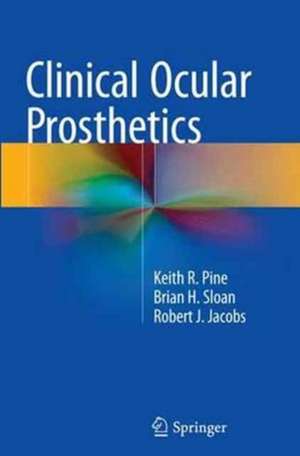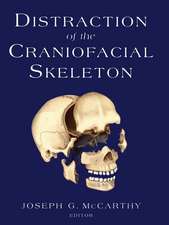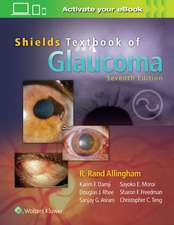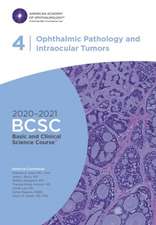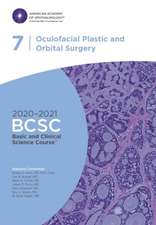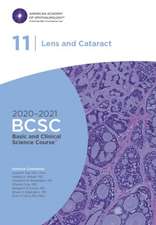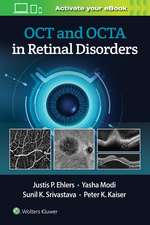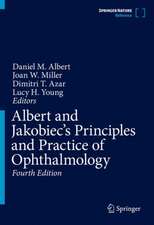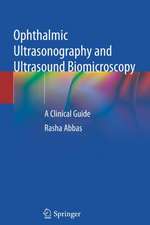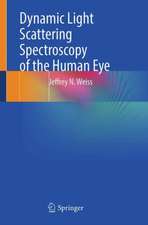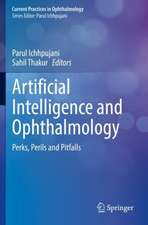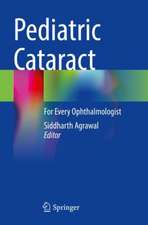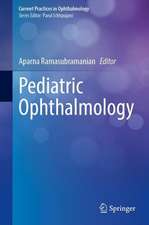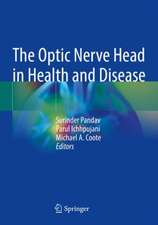Clinical Ocular Prosthetics
Autor Keith R. Pine, Brian H. Sloan, Robert J. Jacobsen Limba Engleză Paperback – 15 oct 2016
The book describes the psychological, anatomical and physiological aspects of eye loss as well as surgical procedures for removing the eye, patient evaluation, constructing prosthetic eyes (including prosthetic and surgical techniques for dealing with socket complications), the socket’s response to prosthetic eyes, prosthetic eye maintenance and the history of prosthetic eyes.
Though primarily intended for prosthetists, ophthalmologists, ophthalmic nurses, optometrists and students in the fields of ocular medicine, maxillofacial medicine and anaplastology, the book also offers a useful resource for other health workers and family members who care for prosthetic eye patients, and for those patients seeking a deeper understanding of the issues affecting them than they can find elsewhere.
| Toate formatele și edițiile | Preț | Express |
|---|---|---|
| Paperback (1) | 757.90 lei 38-44 zile | |
| Springer International Publishing – 15 oct 2016 | 757.90 lei 38-44 zile | |
| Hardback (1) | 1168.50 lei 6-8 săpt. | |
| Springer International Publishing – 21 iul 2015 | 1168.50 lei 6-8 săpt. |
Preț: 757.90 lei
Preț vechi: 797.79 lei
-5% Nou
145.04€ • 150.57$ • 120.94£
Carte tipărită la comandă
Livrare economică 18-24 martie
Specificații
ISBN-10: 3319366335
Pagini: 369
Ilustrații: L, 319 p. 415 illus., 397 illus. in color.
Dimensiuni: 155 x 235 x 18 mm
Greutate: 0.64 kg
Ediția:Softcover reprint of the original 1st ed. 2015
Editura: Springer International Publishing
Colecția Springer
Locul publicării:Cham, Switzerland
Cuprins
Notă biografică
Robert J. Jacobs, MSc, PhD Melb., GradDipBus LOSc, FAAO, is an Associate Professor in the Department of Optometry and Vision Science, University of Auckland, New Zealand. He is a Fellow of the American Academy of Optometry, an honorary member of the New Zealand Association of Optometrists, an Associate Editor of the journal Clinical and Experimental Optometry, and a Director of the Optometry Council of Australia and New Zealand.
Brian H. Sloan, MB ChB, FRANZCO, works in both private and public practice and is an Honorary Senior Lecturer in the Department of Ophthalmology, University of Auckland, New Zealand (NZ). He has held fellowships in the subspecialty of Oculoplastic, Lacrimal, and Orbital Surgery in Melbourne, Australia; Cincinnati, Ohio, USA; and Vancouver, Canada. He is a Senior Inspector of Training Posts for the Royal Australian and NZ College of Ophthalmologists (RANZCO), and the immediate past Chairman of the RANZCO NZ branch Qualifications and Education Committee.
Textul de pe ultima copertă
The book describes the psychological, anatomical and physiological aspects of eye loss as well as surgical procedures for removing the eye, patient evaluation, constructing prosthetic eyes (including prosthetic and surgical techniques for dealing with socket complications), the socket’s response to prosthetic eyes, prosthetic eye maintenance and the history of prosthetic eyes.
Though primarily intended for prosthetists, ophthalmologists, ophthalmic nurses, optometrists and students in the fields of ocular medicine, maxillofacial medicine and anaplastology, the book also offers a useful resource for other health workers and family members who care for prosthetic eye patients, and for those patients seeking a deeper understanding of the issues affecting them than they can find elsewhere.
Caracteristici
Descriere
This is the first textbook to offer a comprehensive account of ocular prosthetics and the evidence used to underpin and support this field of healthcare. It does so by bringing together information from ophthalmology, prosthetic eye and contact lens literature, and from experts actively engaged in these fields.
The book describes the psychological, anatomical and physiological aspects of eye loss as well as surgical procedures for removing the eye, patient evaluation, constructing prosthetic eyes (including prosthetic and surgical techniques for dealing with socket complications), the socket’s response to prosthetic eyes, prosthetic eye maintenance and the history of prosthetic eyes.
Though primarily intended for prosthetists, ophthalmologists, ophthalmic nurses, optometrists and students in the fields of ocular medicine, maxillofacial medicine and anaplastology, the book also offers a useful resource for other health workers and family members who care for prosthetic eye patients, and for those patients seeking a deeper understanding of the issues affecting them than they can find elsewhere.
